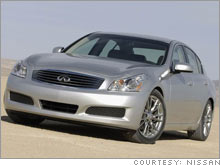Crash death rates show progress in auto safetySUVs, in particular, now much safer with addition of stability control.NEW YORK (CNNMoney.com) -- New statistics released Thursday by the Insurance Institute for Highway Safety show that, overall, driving has gotten much safer in the last 11 years. During the years 2002 to 2005, there were 79 driver deaths per million registered 2001-2004 model year vehicles, according to the Institute. By contrast, during the years 1990 to 1994, there were 110 deaths per million 1989 to 1993 model year vehicles on the road then. That represents a 30 percent reduction in the overall death rate.
Most of that difference can be attributed to safer vehicle designs and to the addition of Electronic Stability Control on more vehicles, especially SUVs, according to the Institute. The vehicles with the lowest death rates were the General Motors' (Charts, Fortune 500) Chevrolet Astro van, the Infiniti G35 sedan, the BMW 7-series sedan and the Audi A4/S4 Quattro. The Astro, a full-sized van, had a death rate of 7 per million. The Audi A4/S4 had 14 deaths per million registered cars. The vehicles with the highest fatality rates were 2-door, 2-wheel-drive versions of the Chevrolet Blazer small SUV, the Acura RSX small car, the Nissan 350Z sports car, the Kia Spectra compact car, the Pontiac Sunfire compact car and the Kia Rio subcompact car. Death rates for those cars ranged from 232 per million for the Blazer to 175 for the Rio. Death rates are computed based on data from the Federal Government's Fatality Analysis Reporting System and vehicle registration data from The Polk Company. Since men tend to die more often in traffic crashes than women, the Institute statistically adjusts the data to account for models with more male or female drivers . Overall, midsize and large luxury cars have the lowest death rates, according to the Institute, while small 4-door cars have the highest death rates. Of the 15 vehicles with the lowest death rates, none were small cars. Not that drivers have to get the largest vehicles to be safe, said Insurance Institute spokesman Russ Rader. "You don't have to buy a tank to get safety," he said. Midsized cars, especially those with smaller four and six cylinder engines, provide excellent fuel economy and have relatively low fatality rates, said Rader. Differences in drivers, not just the vehicles themselves, can also influence death rates, according to the Insurance Institute. For example, expensive luxury cars may be safer than less expensive cars, but less expensive cars are also purchased by younger, less experienced drivers which may partly account for higher death rates. Stability control shows its importance All but three of the vehicles with the lowest death rates have Electronic Stability Control, usually as standard equipment. By contrast, ESC is available on only one of the 16 vehicles with the worst fatality rates. On the one that does have it, the Nissan 350Z, it's available only as an option. ESC uses sensors to monitor for various signs of skidding. Computerized systems intervene to immediately bring the vehicle under control when the first signs of a skid are detected. Other studies by the Insurance Institute have compared death rates for identical vehicles with and without ESC. Those studies have shown that ESC reduces fatal single-vehicle crashes- the type of crash that usually involves a vehicle losing control and going off the road - by more than half, according to the Institute, while reducing multivehicle wrecks by a third. SUVs, which are taller than cars, are more prone to dangerous single-vehicle crashes, especially rollovers. For that reason, ESC could be particularly important in reducing fatalities in those types of vehicles. Of the 15 vehicles with the lowest death rates, six were SUVs. All but one of those SUVs have ESC as standard equipment. "That's a big change from previous years," said Russ Rader, a spokesman for the Insurance Institute. "SUVs have never been stars in the safety arena." Besides SUVs, sports cars are another type of vehicle in which drivers tend to die in single-vehicle, rather than multi-vehicle, crashes. (The opposite is true for most vehicles.) Presumably, that is because, while sports cars have higher handling limits than other cars, drivers tend to test those limits in more often in sports cars. The National Highway Traffic Safety Administration recently proposed a rule requiring ESC on all vehicles by 2012. According to analyses by NHTSA and the Insurance Institute, putting ESC on all vehicles could save as many as 10,000 lives per year. To see the full report, as well crash test results for cars, go to the Insurance Institute for Highway Safety's website at IIHS.org. To see crash test results from the federal government, go to the National Highway Traffic Safety Administration's website at safercar.gov. |
|

